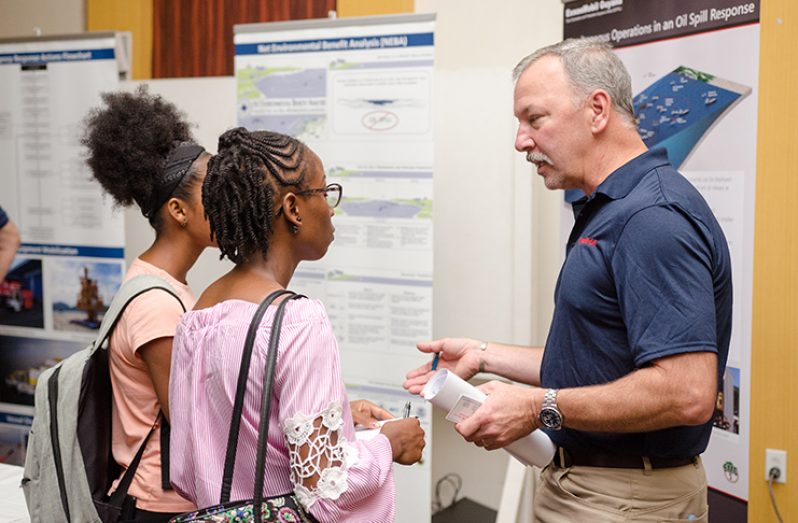EXXONMOBILl’s subsidiary, Esso Exploration and Production Guyana Limited (EEPGL) hosted an Open House discussion on Monday on the environmental implications of its third oil development project called Payara in the Stabroek Block.
Members of the public and students of the University of Guyana (UG) were made aware of the upcoming Payara Development Project and how Esso Exploration & Production Guyana Limited (EEPGL), a subsidiary of ExxonMobil, is working to maximise safety and environmental protection.

The Open House event which saw scores in attendance was held at the Pegasus Hotel on Monday and took the form of several booth displays dealing with matters from oil spills to production and operations. They engaged with both local and international experts on key topics at different booths regarding the Environmental Impact Assessment (EIA) that was done for it. It was also revealed that there is potential for a third Floating Production, Storage, and Offloading (FPSO) to be used during production which would be named ‘Prosperity’ at the event. Speaking with the gathering ExxonMobil’s Country Manager, Rod Henson said, “We want to give you a chance to learn a little bit more about the studies that are being conducted for this Payara project as well as answer questions and discuss the topics that might be of interest to you.”
Additionally, ExxonMobil’s Guyana Senior Director of Public and Government Affairs, Deedra Moe told the newspaper that she was pleased with the number of persons who turned out to the event.
“To me, it’s an opportunity for everyone to learn a little bit more about the industry in general; this particular project that we’re working on; potential impacts and how we plan to mitigate and take care of the environment during the project. I think it’s a great opportunity for that and it’s important for us to engage stakeholders at all levels, particularly students who are up and coming and wanting to learn more,” she explained.
Exxon explained that it welcomes all questions and commentary from citizens as it relates to the Payara EIA and revealed that he will soon be visiting other Regions to ensure that others in the country can receive the same updated information on the project. Back in September, EEPGL submitted its Energy Information Administration (EIA) on the Payara Development Project to the Environmental Protection Agency (EPA). The project, located in the eastern half of the Stabroek Block, will see the drilling of up to 45 development wells which could take up to five years, with drilling beginning in 2020 and initial production by early 2023.

The Environmental Advisory Board and other government agencies will consider the Payara Development Project, before deciding whether, and under what conditions, EEPGL’s application for environmental authorisation for the project can be granted. The project marks EEPGL’s third development field in the Stabroek block offshore Guyana. The proposed development is targeting 180,000 to 220,000 barrels of oil per day with anticipations to produce approximately 5,700,000 to 6,600,000 barrels of crude oil per month.
Oil production from the project is expected to last at least 20 years and to result in the employment of some 600 persons during development well drilling; some 600 persons at the peak of the installation stage and up to 140 persons during production operations.
Its concept is similar to that of the Liza Phase One and Phase Two projects and will include the installation and operation of subsea, umbilicals, risers, and flowlines equipment; installation and operation of a Floating Production, Storage, and Offloading (FPSO) vessel in the eastern half of the Stabroek Block and ultimately, project decommissioning.



.jpg)








